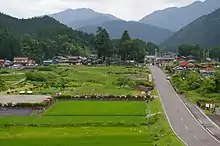| Neodani Fault | |
|---|---|
| Location | Gifu Prefecture |
| Coordinates | 35°37′00″N 136°37′11″E / 35.61667°N 136.61972°E |
| Country | Japan |
| State | Gifu Prefecture |
| Tectonics | |
| Earthquakes | 1891 Mino-Owari earthquake |
| Type | left lateral slip fault |

This fault can be seen as a step portion in the center of the photo.
%252C_SRTM-1.gif)
Neodani Fault.
Neodani Fault (根尾谷断層, Neodani Dansō) is a left lateral slip fault in central Japan, Gifu Prefecture, which ruptured causing the 1891 Mino–Owari earthquake (otherwise known as the Nōbi earthquake) in 1891. It caused a 6m vertical offset and 8m left lateral offset, and ruptured over 80 km.[1] The quake was the largest ever recorded in inland Japan.
See also
References
- ↑ "Long-Term Seismic Behavior of a Fault Involved in a Multiple-Fault Rupture: Insights from Tectonic Geomorphology along the Neodani Fault, Central Japan" (PDF). Archived from the original (PDF) on 23 Jul 2011. Retrieved 19 May 2021.
External links
Wikimedia Commons has media related to Neodani Fault.
- Seismic Faults Observation & Experience House
- Long-Term Seismic Behavior of a Fault Involved in a Multiple-Fault Rupture: Insights from Tectonic Geomorphology along the Neodani Fault, Central Japan
This article is issued from Wikipedia. The text is licensed under Creative Commons - Attribution - Sharealike. Additional terms may apply for the media files.